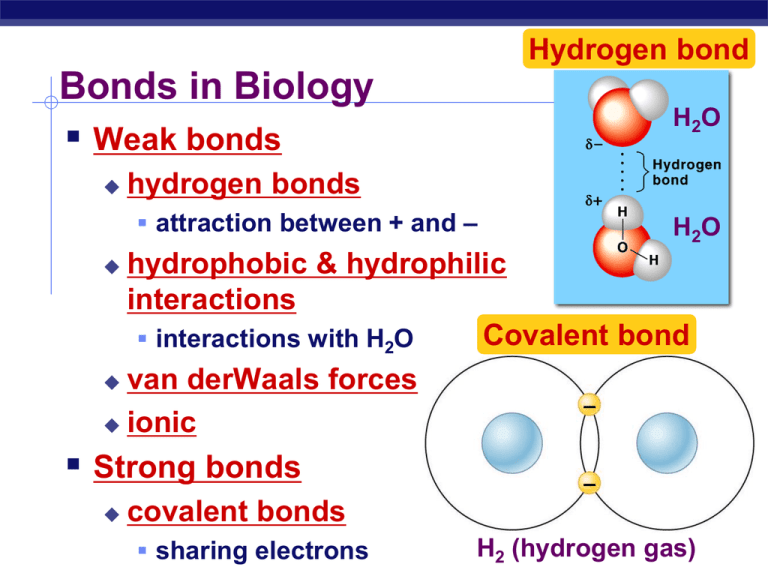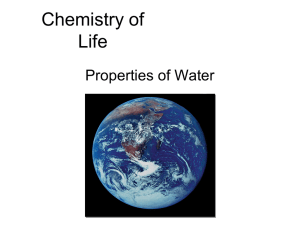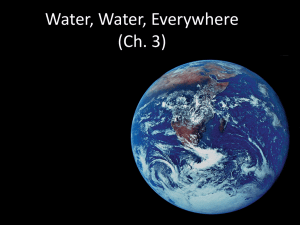The Chemistry of Life
advertisement

Hydrogen bond Bonds in Biology Weak bonds H2O hydrogen bonds attraction between + and – H2O hydrophobic & hydrophilic interactions Covalent bond interactions with H2O van derWaals forces – ionic Strong bonds – covalent bonds sharing electrons H2 (hydrogen gas) Chemistry of Life Properties of Water More about Water Why are we studying water? All life occurs in water inside & outside the cell Chemistry of water H2O molecules form H-bonds with each other +H attracted to –O creates a sticky molecule Elixir of Life Special properties of water 1. cohesion & adhesion surface tension, capillary action 2. good solvent many molecules dissolve in H2O hydrophilic vs. hydrophobic 3. lower density as a solid ice floats! 4. high specific heat water stores heat 5. high heat of vaporization heats & cools slowly 1. Cohesion & Adhesion Cohesion H bonding between H2O molecules water is “sticky” surface tension Adhesion H bonding between H2O & other substances capillary action meniscus water climbs up paper towel or cloth Cohesion +adhesion How does H2O get to top of trees? Transpiration is built on cohesion & adhesion 2. Water is the solvent of life Polarity makes H2O a good solvent polar H2O molecules surround + & – ions solvents dissolve solutes creating solutions What dissolves in water? Hydrophilic substances have attraction to H2O polar or non-polar? What doesn’t dissolve in water? Hydrophobic substances that don’t have an attraction to H2O polar or non-polar? fat (triglycerol) 3. The special case of ice Most (all?) substances are more dense when they are solid, but not water… Ice floats! H bonds form a crystal Why is “ice floats” important? Oceans & lakes don’t freeze solid surface ice insulates water below allowing life to survive the winter if ice sank… ponds, lakes & even oceans would freeze solid in summer, only upper few inches would thaw seasonal turnover of lakes sinking cold H2O cycles nutrients in autumn 4. Specific heat H2O resists changes in temperature high specific heat takes a lot to heat it up takes a lot to cool it down H2O moderates temperatures on Earth Specific heat & climate Evaporative cooling 5. Heat of vaporization Organisms rely on heat of vaporization to remove body heat Ionization of water & pH Water ionizes H+ splits off from H2O, leaving OH– if [H+] = [-OH], water is neutral if [H+] > [-OH], water is acidic if [H+] < [-OH], water is basic pH scale how acid or basic solution is 1 7 14 H2O H+ + OH– H+ Ion Concentration pH Examples of Solutions 100 0 10–1 1 10–2 2 Stomach acid, Lemon juice 10–3 3 Vinegar, cola, beer 10–4 4 Tomatoes pH1 pH2 10-1 10-2 10–5 5 Black coffee, Rainwater 10–6 6 Urine, Saliva 10 times less H+ 10–7 7 Pure water, Blood pH8 pH7 10-8 10-7 10–8 8 Seawater 10–9 9 Baking soda 10 times more H+ 10–10 10 Great Salt Lake pH10 pH8 10-10 10-8 10–11 11 Household ammonia 10–12 12 Household bleach 10–13 13 Oven cleaner 10–14 14 Sodium hydroxide pH Scale tenfold change in H+ ions 100 times more H+ Hydrochloric acid Buffers & cellular regulation pH of cells must be kept ~7 pH affects shape of molecules shape of molecules affect function therefore pH affects cellular function Control pH by buffers reservoir of H+ 7 donate H+ when [H+] falls 6 absorb H+ when [H+] rises 5 4 pH 9 8 Buffering range 3 2 1 0 0 1 2 3 4 5 Amount of base added







